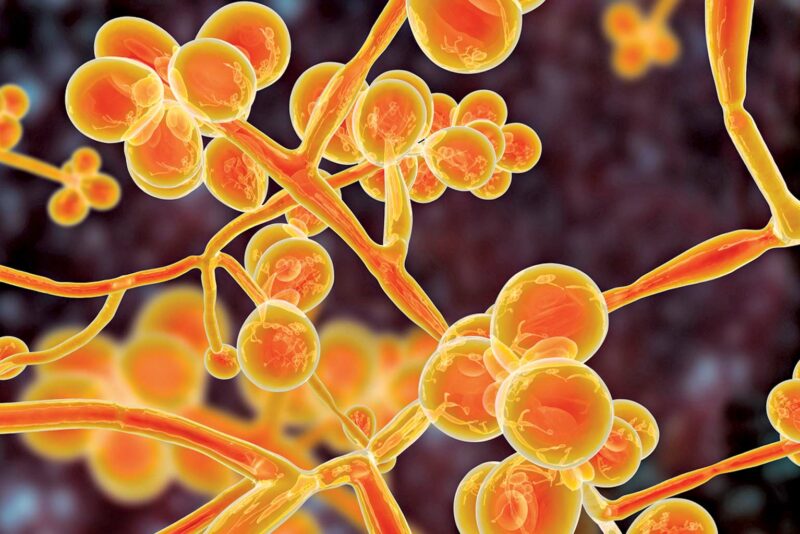Investigating The Spread Of A Dangerous Fungus In A Changing Climate

Table of Contents
The Impact of Climate Change on Fungal Growth and Reproduction
Increased Temperatures and Humidity
Rising temperatures and humidity create ideal breeding grounds for many fungi. Warmer conditions accelerate fungal metabolism, leading to faster growth and reproduction rates. Increased humidity provides the necessary moisture for spore germination and development. This translates to a more rapid spread of fungal pathogens and an increased potential for outbreaks.
- Examples: Candida auris, a particularly dangerous fungus resistant to many antifungal drugs, thrives in warmer environments. Similarly, Aspergillus fumigatus, a common cause of respiratory infections, shows increased growth at higher temperatures.
- Temperature's Impact on Spore Production: Elevated temperatures often stimulate increased spore production, leading to a greater inoculum available for dispersal. This results in a higher likelihood of infection in both humans and plants.
- Studies: Numerous studies have demonstrated a clear correlation between increasing global temperatures and the emergence and spread of various fungal diseases, highlighting the significant role of climate change in this alarming trend.
Altered Precipitation Patterns
Changes in rainfall patterns significantly impact fungal growth and spread. Increased frequency of extreme rainfall events creates conditions favorable for fungal growth by providing abundant moisture. Conversely, prolonged droughts, followed by heavy rains, can stress plants, making them more susceptible to fungal infections.
- Favorable Precipitation Patterns: Many fungi require specific moisture levels for optimal growth. Changes in rainfall patterns can alter the distribution and abundance of these fungi.
- Water Availability: Water availability is crucial for fungal spore germination. Increased rainfall directly increases the chances of spore germination and subsequent infection.
- Drought Stress: Droughts can weaken plants, reducing their natural defenses against fungal pathogens. Subsequent heavy rains can then trigger widespread fungal infections in these stressed plants. This effect is particularly concerning for agricultural crops.
Mechanisms of Fungal Spread in a Changing Climate
Increased Vector Activity
Warmer temperatures influence the activity and distribution of insect vectors, such as mosquitoes and flies, which can act as carriers of fungal spores. Increased insect populations and extended activity periods due to climate change facilitate the dispersal of fungal pathogens over wider geographical areas.
- Fungal Vectors: Many fungi rely on insect vectors for their dispersal. Changes in insect activity directly impact the spread of these fungal pathogens.
- Climate Change Impact on Insect Populations: Climate change can affect insect populations in various ways, influencing their abundance and distribution. Warmer temperatures can lead to increased insect populations and prolonged activity periods, extending the window for fungal spore transmission.
- Migratory Patterns: Changes in climate can also alter migratory patterns of insect vectors, potentially introducing fungal pathogens to new regions.
Enhanced Spore Dispersal
Climate change alters wind patterns and air circulation, leading to more efficient long-distance spore dispersal of fungi. More frequent and intense storms can further enhance spore dispersal over vast distances.
- Wind Currents and Air Quality: Wind patterns play a critical role in the dispersal of fungal spores. Changes in wind speed and direction, influenced by climate change, can affect the distance and efficiency of spore dispersal.
- Impact of Climate Change on Air Circulation: Climate change can alter atmospheric circulation patterns, creating conditions favorable for the long-range transport of fungal spores.
- Storms and Spore Dispersal: Increased frequency and intensity of storms can significantly increase the dispersal of fungal spores over large distances, potentially leading to outbreaks in new regions.
Consequences of Increased Fungal Spread
Impacts on Human Health
The spread of dangerous fungi poses a significant threat to human health. Increased incidence of fungal infections, particularly in vulnerable populations like immunocompromised individuals, is a growing concern. The emergence of drug-resistant fungi, such as Candida auris, further exacerbates this problem.
- Fungal Diseases and their Impact: Fungal infections can range from mild skin infections to life-threatening systemic diseases. The consequences can be severe, especially in individuals with weakened immune systems.
- Dangerous Fungi and Virulence: Certain fungi possess high virulence, capable of causing severe and often fatal infections.
- Challenges in Diagnosis and Treatment: Diagnosing and treating fungal infections can be challenging, particularly those caused by drug-resistant species.
Impacts on Agriculture and Ecosystems
Fungal diseases significantly impact agricultural production and ecosystem health. Decreased crop yields, tree mortality, and biodiversity loss are major consequences of increased fungal spread. This has substantial economic and ecological repercussions.
- Vulnerable Crops and Ecosystems: Many crops and ecosystems are highly susceptible to fungal pathogens. Climate change-induced alterations in environmental conditions are further increasing their vulnerability.
- Economic Impacts on Agriculture: Fungal diseases can cause devastating economic losses in agriculture, impacting food security and livelihoods.
- Role in Ecosystem Collapse: Widespread fungal infections can contribute to ecosystem collapse by reducing biodiversity and disrupting ecological processes.
Conclusion
The spread of a dangerous fungus in a changing climate presents a multifaceted challenge with far-reaching consequences. We have seen how climate change significantly influences fungal growth, reproduction, and dispersal, leading to increased incidence of fungal diseases and devastating impacts on human health, agriculture, and ecosystems. Understanding these complex interactions is crucial for developing effective strategies to mitigate these threats. By addressing climate change and implementing effective disease management strategies, we can work towards protecting human health and safeguarding our ecosystems from the harmful effects of these dangerous fungal pathogens. Learn more about the work of the CDC and WHO on fungal infections and contribute to the fight against the spread of these dangerous pathogens.

Featured Posts
-
 Rekord Svadeb Na Krasivuyu Datu V Kharkovskoy Oblasti 89 Par
May 25, 2025
Rekord Svadeb Na Krasivuyu Datu V Kharkovskoy Oblasti 89 Par
May 25, 2025 -
 Country Property Investment Lessons From Nicki Chapmans Success
May 25, 2025
Country Property Investment Lessons From Nicki Chapmans Success
May 25, 2025 -
 Discover Local Connect Globally The Ae Xplore Campaign At England Airpark And Alexandria International Airport
May 25, 2025
Discover Local Connect Globally The Ae Xplore Campaign At England Airpark And Alexandria International Airport
May 25, 2025 -
 La Chine Et La Liberte D Expression En France Le Cas Des Dissidents
May 25, 2025
La Chine Et La Liberte D Expression En France Le Cas Des Dissidents
May 25, 2025 -
 Yevrobachennya 2013 2023 Doli Peremozhtsiv Konkursu
May 25, 2025
Yevrobachennya 2013 2023 Doli Peremozhtsiv Konkursu
May 25, 2025
Latest Posts
-
 George L Russell Jr S Passing A Loss For Marylands Legal And Political Communities
May 25, 2025
George L Russell Jr S Passing A Loss For Marylands Legal And Political Communities
May 25, 2025 -
 Maryland Mourns The Passing Of Legal Luminary George L Russell Jr
May 25, 2025
Maryland Mourns The Passing Of Legal Luminary George L Russell Jr
May 25, 2025 -
 George Russells Mercedes Future Wolff Drops Another Clue
May 25, 2025
George Russells Mercedes Future Wolff Drops Another Clue
May 25, 2025 -
 Mercedes And George Russell Contract Renewal Hinges On This One Factor
May 25, 2025
Mercedes And George Russell Contract Renewal Hinges On This One Factor
May 25, 2025 -
 Toto Wolffs Latest Comments On George Russells Mercedes Future
May 25, 2025
Toto Wolffs Latest Comments On George Russells Mercedes Future
May 25, 2025
